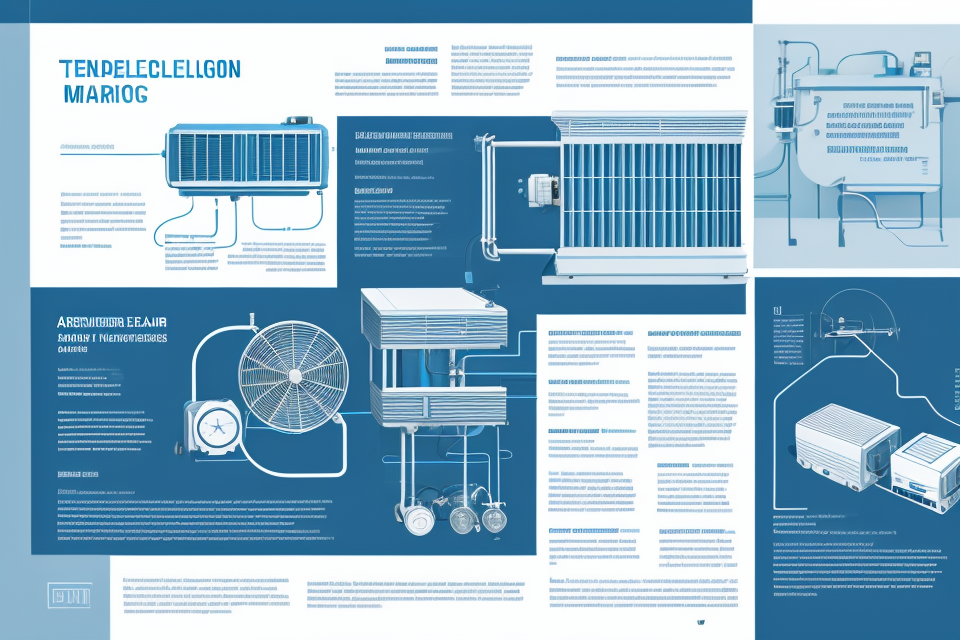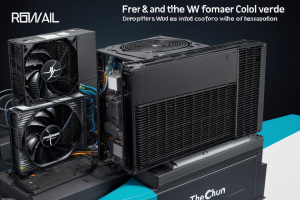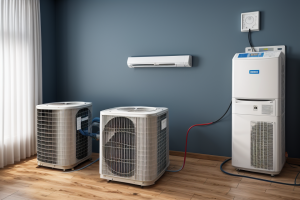
Are you tired of constantly adjusting your thermostat throughout the day? Are you experiencing uncomfortable temperature fluctuations in your home or office? These may be signs of overcooling, a common issue in HVAC systems. Overcooling occurs when an HVAC system is set to a low temperature, causing the air conditioning to work harder and use more energy than necessary. This can lead to increased energy bills, reduced comfort, and even damage to the HVAC system. In this article, we will explore the causes of overcooling and provide tips on how to prevent it.
Common Issues with Overcooling
Inadequate thermostat settings
Adjusting thermostat settings is an effective way to prevent overcooling in HVAC systems. Here are some tips on how to adjust thermostat settings and why regular thermostat maintenance is important.
Adjusting Thermostat Settings
- Check the current temperature setting: The first step in preventing overcooling is to check the current temperature setting on the thermostat. If the setting is too low, it can cause the system to work harder and cool the space too much. Adjust the setting to a more appropriate temperature based on the desired comfort level.
- Consider programmable thermostats: Programmable thermostats allow you to set different temperature settings for different times of the day. This can help ensure that the system is not running unnecessarily and can save energy costs.
- Consider a smart thermostat: Smart thermostats can learn your temperature preferences and adjust the system accordingly. They can also be controlled remotely, which can be helpful if you’re away from home or work.
Regular Thermostat Maintenance
- Clean the thermostat: Dust and debris can accumulate on the thermostat, which can affect its accuracy. Regularly clean the thermostat to ensure that it is functioning properly.
- Check the wiring: If the wiring is damaged or faulty, it can cause the thermostat to malfunction and result in overcooling. Check the wiring regularly and repair any issues as needed.
- Update the thermostat: If the thermostat is old or outdated, it may not be functioning properly. Consider updating the thermostat to a newer model that is more energy efficient and accurate.
Overall, inadequate thermostat settings can cause overcooling in HVAC systems. Adjusting the settings and regularly maintaining the thermostat can help prevent this issue and ensure that the system is running efficiently.
Dirty or clogged filters
One of the most common issues that can cause overcooling in HVAC systems is dirty or clogged filters. When the filters become dirty or clogged, they restrict the flow of air, causing the system to work harder and produce less cool air.
How to check and replace filters
Checking and replacing filters is a simple solution to prevent overcooling. Here’s how:
- Turn off the power to the HVAC system before attempting to access the filters.
- Remove the filter cover or access panel to expose the filters.
- Check the filters for dirt, dust, or debris. If they appear dirty, it’s time to replace them.
- Remove the old filters and replace them with new ones. Make sure to follow the manufacturer’s instructions for proper installation.
How dirty filters can cause overcooling
Dirty filters can cause overcooling by restricting the flow of air through the system. When the filters become clogged, they reduce the amount of air that can flow through the system, causing the evaporator coil to become too cold. This can lead to excessive cooling, resulting in overcooling. Additionally, dirty filters can also cause the compressor to work harder, leading to higher energy consumption and potential damage to the system.
It’s important to regularly check and replace filters to prevent overcooling and ensure the efficient operation of your HVAC system.
Inadequate insulation
Inadequate insulation is a common issue that can lead to overcooling in HVAC systems. Insulation plays a crucial role in maintaining the temperature of a building by reducing heat transfer through the walls, roof, and floors. When a building’s insulation levels are insufficient, it allows heat to escape, which can cause the HVAC system to work harder and produce colder air to compensate.
- How to check insulation levels
To check insulation levels, start by visually inspecting the building’s exterior for any gaps or holes in the walls, roof, or floors. Next, use a thermal imaging camera to detect any areas of heat loss. You can also hire a professional insulation contractor to perform a comprehensive insulation assessment.
- Importance of proper insulation in preventing overcooling
Proper insulation is essential in preventing overcooling in HVAC systems. It helps to maintain the temperature of the building by reducing heat transfer, which can lead to increased energy efficiency and reduced energy costs. Additionally, proper insulation can help to extend the lifespan of the HVAC system by reducing the workload on the system and preventing excessive wear and tear. By ensuring that the building’s insulation levels are adequate, homeowners and building managers can enjoy a more comfortable and energy-efficient environment.
Causes of Overcooling
Inadequate compressor or condenser coils
Inadequate compressor or condenser coils can cause overcooling in HVAC systems. These components play a crucial role in maintaining the temperature and pressure within the system. If they are not functioning properly, it can lead to an imbalance in the system, resulting in overcooling.
How to check compressor and condenser coils
To check for inadequate compressor or condenser coils, it is essential to perform a thorough inspection of the components. Start by turning off the power to the unit and allowing it to cool down before beginning the inspection. Look for any signs of damage, such as leaks, corrosion, or rust. Also, check for any buildup of dirt or debris on the coils, which can impede their functioning.
How to maintain and replace compressor and condenser coils
Maintaining and replacing compressor and condenser coils is crucial to prevent overcooling in HVAC systems. Here are some tips on how to do it:
- Clean the coils regularly: Dirt and debris can accumulate on the coils, making them less efficient. Use a brush or vacuum cleaner to remove any buildup.
- Check for leaks: Look for any signs of leaks in the system, such as water stains or wet spots around the unit. A leak can cause damage to the coils and impede their functioning.
- Replace damaged coils: If the coils are damaged, they need to be replaced as soon as possible. This will ensure that the system is functioning efficiently and prevent overcooling.
- Replace coils periodically: Coils wear out over time and need to be replaced periodically. Check the manufacturer’s recommendations for replacement intervals.
Inadequate compressor or condenser coils can cause overcooling in HVAC systems. It is essential to check for any signs of damage or buildup on the coils and maintain them regularly to prevent overcooling.
Leaks in the refrigerant lines
Refrigerant leaks can cause overcooling in HVAC systems. When refrigerant leaks occur, the system’s cooling capacity is reduced, leading to undercooling. The following are the steps to detect leaks in refrigerant lines:
- Inspect the system for visible signs of leaks, such as wet spots or icing on the lines.
- Use a refrigerant leak detector to locate any hidden leaks.
- Check the system’s pressure and temperature to determine if there are any leaks.
It is important to regularly maintain the refrigerant levels in the system to prevent leaks from occurring. A technician should be called to fix any leaks that are found.
Overcooling can also occur when the refrigerant lines are not properly charged. This can be fixed by adding more refrigerant to the system.
Proper maintenance of the refrigerant lines is crucial to prevent overcooling in HVAC systems.
Blocked or dirty evaporator coils
- Evaporator coils are an essential component of an HVAC system as they remove heat from the air and transfer it to the refrigerant.
- Over time, evaporator coils can become blocked or dirty, which can cause overcooling in the system.
- A blocked evaporator coil is typically caused by dust, dirt, or debris that accumulates in the coil and restricts airflow.
- Dirty evaporator coils, on the other hand, are caused by the buildup of dirt, dust, and other contaminants on the coil’s surface.
- These contaminants can impede the heat transfer process and cause the evaporator coil to become dirty and less efficient.
- A dirty evaporator coil can also cause the system to freeze up, which can result in costly repairs and downtime.
- It is essential to check the evaporator coils regularly and clean them if necessary to prevent overcooling and ensure the HVAC system is operating efficiently.
- To check the evaporator coils, turn off the power to the HVAC system and remove the access panel to access the coils.
- Use a flashlight to inspect the coils for any signs of dirt, dust, or debris.
- If the coils are dirty, use a vacuum cleaner with a HEPA filter to remove the contaminants.
- If the coils are blocked, use a brush or compressed air to remove the blockage.
- After cleaning the evaporator coils, turn the power back on and test the system to ensure it is functioning correctly.
Inadequate air circulation
One of the main causes of overcooling in HVAC systems is inadequate air circulation. This occurs when the air is not being distributed evenly throughout the space, resulting in some areas being too cold while others remain too warm. This can happen due to a variety of reasons, such as blocked or malfunctioning vents, insufficient air ducts, or incorrect air duct placement.
How to improve air circulation
To improve air circulation and prevent overcooling, there are several steps that can be taken. Firstly, it is important to ensure that all vents are clear of any obstructions, such as furniture or curtains, to allow for proper airflow. Additionally, checking and cleaning the air filters can help to increase air circulation by allowing more air to flow through the system.
Another effective method is to increase the number of air outlets or vents in the room. This can help to distribute the cold air more evenly and prevent some areas from becoming too cold while others remain too warm. It is also important to ensure that the air ducts are the correct size and are placed in the correct locations to maximize air circulation.
Importance of proper air circulation in preventing overcooling
Proper air circulation is crucial in preventing overcooling in HVAC systems. When the air is not distributed evenly, it can result in uncomfortable temperatures and inefficiencies in the system. By improving air circulation, the system can operate more efficiently, reducing energy costs and prolonging the lifespan of the equipment. Additionally, proper air circulation can help to improve indoor air quality by reducing the buildup of pollutants and allergens.
FAQs
1. What is overcooling in HVAC systems?
Overcooling occurs when an HVAC system is set to a lower temperature than the desired setpoint, causing the system to cool the space beyond the desired temperature. This can lead to discomfort, increased energy consumption, and equipment damage.
2. What are the common causes of overcooling in HVAC systems?
There are several causes of overcooling in HVAC systems, including improper setpoint temperature, malfunctioning sensors, dirty filters, clogged airflow, incorrect thermostat programming, and insufficient insulation. It is important to identify the root cause of overcooling to properly address the issue.
3. How can I tell if my HVAC system is overcooling?
You can tell if your HVAC system is overcooling by checking the temperature of the space and comparing it to the setpoint temperature. If the space is too cold, it may be overcooling. You can also check the thermostat settings and make sure they are programmed correctly.
4. What are the consequences of overcooling in HVAC systems?
The consequences of overcooling in HVAC systems can include discomfort, increased energy consumption, and equipment damage. Overcooling can also lead to moisture buildup, which can cause mold and mildew growth. Additionally, it can reduce the lifespan of the HVAC system and increase maintenance costs.
5. How can I prevent overcooling in my HVAC system?
To prevent overcooling in your HVAC system, it is important to properly maintain the system and address any issues that may be causing overcooling. This includes regularly changing filters, cleaning the airflow, and making sure the thermostat is programmed correctly. Additionally, it is important to properly insulate the space to prevent heat loss and reduce the need for cooling.







